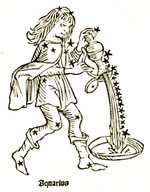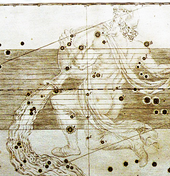Celestial cartography
This article needs additional citations for verification. (August 2010) |


Celestial cartography,[1] uranography,[2][3]
astrography or star cartography[
Etymology
The word "uranography" derived from the
Astrometry
This section needs expansion. You can help by adding to it. (June 2008) |
Astrometry, the science of spherical astronomy, is concerned with precise measurements of the location of celestial bodies in the celestial sphere and their kinematics relative to a reference frame on the celestial sphere.[8] In principle, astrometry can involve such measurements of planets, stars, black holes and galaxies to any celestial body. [9]
Throughout human history, astrometry played a significant role in shaping our understanding of the structure of the visible sky, which accompanies the location of bodies in it, hence making it a fundamental tool to celestial cartography. [9]
Star catalogues
This section needs expansion. You can help by adding to it. (June 2008) |

|

|

|
Hyginus
|
Aquarius according to Johann Bayer's Uranometria, based on Rudolphine Tables |
Aquarius according to KStars |
A determining fact source for drawing star charts is naturally a star table. This is apparent when comparing the imaginative "star maps" of Poeticon Astronomicon – illustrations beside a narrative text from the antiquity – to the star maps of Johann Bayer, based on precise star-position measurements from the Rudolphine Tables by Tycho Brahe.
Important historical star tables
- c:AD 150, Almagest – contains the last known star table from antiquity, prepared by Ptolemy, 1,028 stars.
- c.964, Book of the Fixed Stars, Arabic version of the Almagest by al-Sufi.
- 1627, Rudolphine Tables – contains the first West Enlightenment star table, based on measurements of Tycho Brahe, 1,005 stars.
- 1690, Prodromus Astronomiae – by Johannes Hevelius for his Firmamentum Sobiescanum, 1,564 stars.
- 1729, Britannic Catalogue – by John Flamsteed for his Atlas Coelestis, position of more than 3,000 stars by accuracy of 10".
- 1903, Bonner Durchmusterung – by Friedrich Wilhelm Argelanderand collaborators, circa 460,000 stars.
Star atlases
Naked-eye
- 15th century BC – The ceiling of the tomb TT71 for the Egyptian architect and minister Senenmut, who served Queen Hatshepsut, is adorned with a large and extensive star chart.
- c. 1 CE ? Poeticon astronomicon, allegedly by Gaius Julius Hyginus
- 1092 – Xin Yi Xiang Fa Yao (新儀 象法要), by .
- 1515 – First European printed star charts[10] published in Nuremberg, Germany, engraved by Albrecht Dürer.
- 1603 – Tabulae Rudolphinae
- 1627 – Julius Schiller published the star atlas Coelum Stellatum Christianum, which replaced pagan constellations with biblical and early Christian figures.
- 1660 – Jan Janssonius' 11th volume of Atlas Major (not to be confused with the similarly named and scoped Atlas Maior) featured the Harmonia Macrocosmica by Andreas Cellarius
- 1693 – Firmamentum Sobiescanum sive Uranometria, by Johannes Hevelius, a star map updated with many new star positions based on Hevelius's Prodromus Astronomiae (1690) – 1564 stars.
Telescopic
- 1729 Atlas Coelestis by John Flamsteed
- 1801 Uranographia by Johann Elert Bode
- 1843 Uranometria Nova by Friedrich Wilhelm Argelander
Photographic
- 1914 Franklin-Adams Charts, by John Franklin-Adams, a very early photographic atlas.
- The Falkau Atlas (Hans Vehrenberg). Stars to magnitude 13.
- Atlas Stellarum (Hans Vehrenberg). Stars to magnitude 14.
- True Visual Magnitude Photographic Star Atlas (Christos Papadopoulos). Stars to magnitude 13.5.
- The Cambridge Photographic Star Atlas, Axel Mellinger and Ronald Stoyan, 2011. Stars to magnitude 14, natural color, 1°/cm.
Modern
- Bright Star Atlas – Wil Tirion (stars to magnitude 6.5)
- Cambridge Star Atlas – Wil Tirion (Stars to magnitude 6.5)
- Norton's Star Atlas and Reference Handbook – Ed. Ian Ridpath (stars to magnitude 6.5)
- Stars & Planets Guide – Ian Ridpath and Wil Tirion (stars to magnitude 6.0)[11]
- Cambridge Double Star Atlas – James Mullaney and Wil Tirion (stars to magnitude 7.5)
- Cambridge Atlas of Herschel Objects – James Mullaney and Wil Tirion (stars to magnitude 7.5)
- Pocket Sky Atlas – Roger Sinnott (stars to magnitude 7.5)
- Deep Sky Reiseatlas – Michael Feiler, Philip Noack (Telrad Finder Charts – stars to magnitude 7.5)
- Antonín Bečvář(stars to magnitude 7.75 and about 12,000 clusters, galaxies and nebulae)
- SkyAtlas 2000.0, second edition – Wil Tirion & Roger Sinnott (stars to magnitude 8.5)
- 1987, Uranometria 2000.0 Deep Sky Atlas – Wil Tirion, Barry Rappaport, Will Remaklus (stars to magnitude 9.7; 11.5 in selected close-ups)
- Herald-Bobroff AstroAtlas – David Herald & Peter Bobroff (stars to magnitude 9 in main charts, 14 in selected sections)
- Millennium Star Atlas – Roger Sinnott, Michael Perryman (stars to magnitude 11)
- Field Guide to the Stars and Planets – Jay M. Pasachoff, Wil Tirion charts (stars to magnitude 7.5)
- SkyGX (still in preparation) – Christopher Watson (stars to magnitude 12)
- The Great Atlas of the Sky – Piotr Brych (2,400,000 stars to magnitude 12, galaxies to magnitude 18).[12]
Computerized
- 100,000 Stars
- Cartes du Ciel
- Celestia
- Stars and Planets for Android
- Stars and Planets for iOS
- CyberSky
- GoSkyWatch Planetarium
- Google Sky
- KStars
- Stellarium
- SKY-MAP.ORG
- SkyMap Online
- WorldWide Telescope
- XEphem, for Unix-like systems
- Stellarmap.com – online map of the stars[13]
- Star Walk and Kepler Explorer OpenLab: 2 celestial cartography apps for smartphones
- SpaceEngine
Free and printable from files
See also
- Star chart
- Astrometry
- Cosmography
- Cheonsang Yeolcha Bunyajido
- History of cartography
- Planetarium
- PP3
References
- ^ Warner, D. J. (1979). The Sky Explored: Celestial Cartography 1500–1800. Amsterdam and New York: Theatrum Orbis Terrarum Ltd. and Alan R. Liss, Inc.
- ^ Lovi, G.; W. Tirion; B. Rappaport (1987). "Uranography Yesterday and Today". Uranometria 2000.0. 1: The Northern Hemisphere to – 6 degree. Willmann-Bell, Richmond.
- ^ Lovi, G.; Tirion, W. (1989). Men, Monsters and the Modern Universe. Richmond: Willmann-Bell.
- ^ 1690: Hevelius J., Firmamentum Sobiescianum sive Uranographia.
- ^ c. 1750: Bevis J., Uranographia Britannica.
- ^ 1801: Bode. J. E., Uranographia sive Astrorum Descriptio.
- ^ Burritt, E. H., The Geography of the Heavens, 1833.
- ISBN 978-0-12-088589-3, retrieved 2023-06-08
- ^ ISSN 2296-987X.
- ^ "Dürer's hemispheres of 1515 — the first European printed star charts". Ianridpath.com. Retrieved 2019-02-25.
- ^ "Stars & Planets Guide"
- ^ "The Great Atlas of the Sky" Archived 2012-01-23 at the Wayback Machine, GreatSkyAtlas.com, December 1, 2009.
- ^ "Stellarmap.com". Stellarmap.com. Retrieved 2019-02-25.
External links
- Star Maps from Ian Ridpath's Star Tales website.
- The Mag-7 Star Atlas Project
- Historical Celestial Atlases on the Web
- Felice Stoppa's ATLAS COELESTIS, an extensive collection of 51 star maps and other astronomy related books stored as a multitude of images.
- Monthly star maps for every location on Earth Archived 2007-09-13 at the Wayback Machine
- Easy to use monthly star maps for northern and southern hemispheres. Helpful target lists for naked eye, binocular, or telescope viewing.
- Collection of rare star atlases, charts, and maps Archived 2018-03-25 at the Wayback Machine available in full digital facsimile at Linda Hall Library.
- Navigable online map of the stars, Stellarmap.com.
- The Digital Collections of the Linda Hall Library include:
- "Astronomy: Star Atlases, Charts, and Maps", a collection of more than 60 star atlas volumes.
- "Astronomy: Selected Images, a collection of high-resolution star map images.
- "History of Cosmology: Views of the Stars", high-resolution scans of prints relating to the study of the structure of the cosmos.
